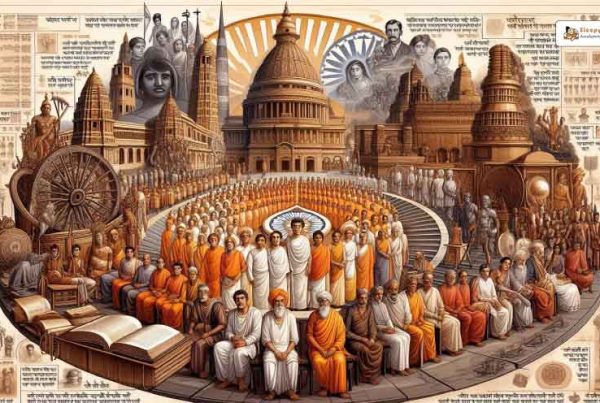Ashoka the Great, one of India’s most celebrated emperors, ruled the Maurya Empire from around 268 to 232 BCE. Known for his transformative journey from a fierce conqueror to a devout follower of Buddhism, Ashoka’s reign is marked by significant events and policies that have left a lasting impact on Indian history and beyond. This article delves into the key aspects of Ashoka’s life and his propagation of Dhamma, focusing on topics that are crucial for UPSC aspirants.
Key Takeaways
- Ashoka’s early life was shaped by his royal lineage and education, setting the stage for his future rule.
- The brutal Kalinga War was a turning point, leading to Ashoka’s embrace of Buddhism and non-violence.
- Ashoka’s Dhamma emphasized moral values, social welfare, and religious tolerance, influencing his governance.
- His edicts, inscribed on rocks and pillars, provide insights into his policies and the spread of Buddhism.
- Ashoka’s legacy endures in modern India, symbolized by the Ashoka Chakra in the national flag and the Lion Capital emblem.
Ashoka’s Early Life and Background
Family and Ancestry
Ashoka, popularly known as Ashoka the Great, was the third Mauryan emperor of Magadha. He was born to Emperor Bindusara and Empress Subhadrangi. His family belonged to the Maurya dynasty, which ruled over a large part of the Indian subcontinent. Ashoka’s lineage was significant, as his grandfather Chandragupta Maurya founded the Maurya Empire.
Education and Upbringing
Ashoka’s early life is not well-documented, but it is known that he received a royal education. He was trained in various arts, including warfare and administration. His upbringing was influenced by the political and cultural environment of the Mauryan court.
Role as a Prince
Before becoming emperor, Ashoka played a crucial role in the administration of the empire. He was appointed as the governor of Ujjain and was responsible for maintaining order in the region. Ashoka also helped suppress a revolt in Takshashila, showcasing his leadership skills early on.
Ashoka’s early experiences as a prince helped shape his future policies and leadership style.
Ascension to the Throne
Ashoka’s rise to power was marked by intense family conflict and political maneuvering. He was not the eldest son of Emperor Bindusara, which meant he was not the obvious heir to the throne. Bindusara preferred his elder son, Susima, to succeed him. However, Ashoka’s skills in military and administration, demonstrated during his time as the governor of Ujjain, made him a strong contender.
Circumstances Leading to Ascension
When Bindusara fell ill, Ashoka returned to the capital, Pataliputra, from Ujjain. According to some accounts, he seized control of the city. The Mahavamsa, a Buddhist chronicle, suggests that Ashoka killed his eldest brother and many of his other stepbrothers to secure his position. Ashoka’s ascension to the throne in 268 BCE was thus a result of both his strategic acumen and ruthless actions.
Challenges Faced
Upon becoming emperor, Ashoka faced numerous challenges. He had to consolidate his power and gain the loyalty of his subjects and officials. The initial years of his reign were marked by efforts to stabilize the empire and assert his authority. Ashoka’s early policies focused on strengthening the central administration and expanding the empire’s influence.
Initial Policies
Ashoka’s initial policies were aimed at consolidating his rule and ensuring the stability of the Mauryan Empire. He implemented administrative reforms to improve governance and took measures to enhance the welfare of his subjects. These early policies laid the foundation for his later, more transformative initiatives following the Kalinga War.
The Kalinga War and Its Aftermath
The Kalinga War, fought in 261 B.C., was a major conflict between the Mauryan Empire and the independent kingdom of Kalinga. Ashoka, the Mauryan emperor, sought to expand his empire and secure control over the strategic region of Kalinga, which is present-day Odisha and northern Andhra Pradesh. The war was driven by Ashoka’s ambition to consolidate his power and the economic and strategic importance of Kalinga.
The battle was fierce and resulted in massive casualties. According to Ashoka’s Rock Edict XIII, 150,000 people were killed, and many more were captured or displaced. The war caused immense suffering, especially to the Brahmana priests and Buddhist monks. The devastation and loss of life left a profound impact on Ashoka, leading to a significant change in his outlook.
Witnessing the horrors of the Kalinga War, Ashoka experienced a deep transformation. He abandoned the policy of physical conquest and adopted a policy of cultural conquest. The sound of war drums, or Bherighosha, was replaced with the sound of Dhamma, or Dhammaghosha. This marked the beginning of Ashoka’s journey towards Buddhism and his commitment to spreading the principles of Dhamma across his empire.
The Kalinga War was a turning point in Ashoka’s life, leading him to embrace non-violence and compassion as guiding principles for his reign.
Ashoka’s Conversion to Buddhism
Ashoka’s conversion to Buddhism marked a significant turning point in his life and reign. The transformation was deeply influenced by the aftermath of the Kalinga War, which left him disturbed by the immense loss of life and suffering. This profound change in Ashoka’s beliefs led him to embrace Buddhism’s principles of non-violence and compassion.
Propagation of Dhamma
Ashoka’s propagation of Dhamma was a significant part of his reign. He used edicts as a medium to propagate the Dhamma policy, serving as communication between him and his subjects. These edicts were inscribed on rocks and pillars across his empire, making the teachings accessible to a wide audience. Ashoka’s Dhamma was not a specific religious faith but a set of moral guidelines aimed at promoting social harmony and ethical behavior.
Principles of Dhamma
The principles of Dhamma included mastery of senses, truthfulness, purity, service, support, and charity. These principles were meant to foster a sense of mutual respect and understanding among the diverse population of the Mauryan Empire. Ashoka emphasized tolerance of different beliefs and ideas, which was crucial in a time of potential conflicts between various religious sects.
Methods of Propagation
Ashoka employed several methods to spread the Dhamma. He sent ambassadors of peace to neighboring kingdoms, including the Greek kingdoms in West Asia and Greece. These diplomatic missions helped in spreading the message of Dhamma beyond the borders of his empire. Additionally, Ashoka organized public gatherings and supported the construction of facilities where people could learn about and practice Dhamma.
Impact on Society
The impact of Ashoka’s Dhamma on society was profound. It led to a climate of mutual trust and harmony, reducing social tensions and conflicts. The emphasis on ethical behavior and social responsibility helped in creating a more cohesive and stable society. Ashoka’s efforts in propagating Dhamma also contributed to the spread of Buddhism, as the principles of Dhamma were closely aligned with Buddhist teachings.
Ashoka’s Edicts and Inscriptions
Ashoka’s edicts are a primary source of knowledge about his reign. These edicts, found on rocks, pillars, and caves, were placed in public areas to reach as many people as possible. They focus on moral duties, social behavior, and Ashoka’s desire to be a benevolent ruler. The edicts of Ashoka are a collection of more than thirty inscriptions attributed to him.
Major Rock Edicts
Ashoka’s major rock edicts are a set of fourteen lengthy inscriptions. They provide practical instructions for governing the kingdom, such as designs for irrigation systems and discussions on peaceful moral behavior. In one of these edicts, Ashoka refers to himself as the King of Magadha.
Pillar Edicts
The pillar edicts are another significant set of inscriptions. These were also placed in public areas and along trade routes. They mainly convey Ashoka’s proclamations to the public and detail his acceptance of Buddhism.
Minor Inscriptions
The minor inscriptions include various smaller edicts and inscriptions. These often focus on specific rules for bhikshu behavior and Ashoka’s views on Dhamma. They provide a more detailed look into his thoughts on social and moral issues.
Ashoka’s Contributions to Buddhism
Construction of Stupas and Temples
Ashoka’s efforts to propagate Buddhism were significant. He built several stupas and monasteries, such as the famous Sanchi and Bharhut stupas. These structures not only served as places of worship but also as centers for spreading Buddhist teachings. Buddhism flourished under Ashoka’s patronage, and his architectural contributions played a crucial role in this.
Support for the Sangha
Ashoka provided extensive support to the Buddhist Sangha, the community of monks and nuns. He made grants and gifts to Buddhist monks and visited several Buddhist shrines, including Sarnath and Kushinagara. His support helped in the growth and stability of the Sangha, ensuring that the teachings of Buddhism were preserved and propagated.
Third Buddhist Council
Ashoka is credited with convening the Third Buddhist Council, which aimed to purify the Buddhist movement of its various corruptions and heresies. This council played a vital role in the spread of Buddhism, as it led to the dispatch of missionaries to various parts of Asia, including Sri Lanka and Greece. The council’s decisions helped in standardizing Buddhist teachings and practices.
Ashoka’s contributions to Buddhism were not just limited to India but had a far-reaching impact on the spread of Buddhism across Asia. His efforts ensured that Buddhism became a major world religion, influencing countless lives and cultures.
Ashoka’s Foreign Relations
Diplomatic Missions
Ashoka, known for his policy of Dhamma, sent emissaries to various regions to spread his message of peace and Buddhism. These missions reached as far as Syria, Egypt, Greece, and Sri Lanka. His long career in the Indian foreign services was marked by these significant diplomatic efforts.
Relations with Hellenistic World
Ashoka maintained friendly relations with the Hellenistic world, including the successors of Alexander the Great. This relationship was mutually beneficial, fostering cultural and economic exchanges. The Greek rulers, in turn, respected Ashoka’s efforts to promote Buddhism and peace.
Impact on Trade
Ashoka’s diplomatic missions and friendly relations with other regions had a positive impact on trade. The exchange of goods, ideas, and culture flourished during his reign, enhancing the prosperity of the Mauryan Empire. This period saw an increase in trade routes and the movement of goods across borders, contributing to the empire’s wealth and stability.
Legacy of Ashoka
Architectural Contributions
Ashoka’s reign left a lasting mark on Indian architecture. He is credited with the construction of numerous stupas and temples, which served as important centers for Buddhist worship and learning. The most famous of these is the Great Stupa at Sanchi, which remains a significant pilgrimage site. Ashoka’s architectural endeavors not only promoted Buddhism but also showcased the artistic and engineering skills of his time.
Symbolism in Modern India
Ashoka’s legacy continues to influence modern India. The emblem of the Republic of India is an adaptation of the Lion Capital of Ashoka, which was originally erected at Sarnath. Additionally, the Ashoka Chakra, a wheel with 24 spokes, is featured at the center of the Indian national flag. These symbols reflect Ashoka’s enduring impact on Indian culture and national identity.
Historical Reassessment
Over the centuries, Ashoka’s reputation has undergone significant reassessment. Initially, much of what was known about him came from Buddhist legends, which portrayed him as an ideal ruler. However, modern scholarship, aided by the decipherment of his inscriptions in the 19th century, has provided a more nuanced view. Today, Ashoka is recognized not only for his patronage of Buddhism but also for his efforts to govern his vast empire through principles of dhamma, or righteous conduct.
Ashoka’s transformation from a conqueror to a proponent of peace and dhamma remains one of the most remarkable stories in history.
Modern Scholarship on Ashoka
Rediscovery in the 19th Century
Ashoka’s existence as a historical emperor had almost been forgotten until the 19th century. The rediscovery began with the decipherment of his edicts by James Prinsep, a British antiquary and colonial administrator. This breakthrough provided a wealth of information about Ashoka’s life and reign, shedding light on his contributions to Buddhism and his propagation of dhamma.
Historiographical Debates
Modern scholars have engaged in various debates about Ashoka’s legacy. Some view his edicts as early examples of political propaganda, aimed at presenting a favorable image of his administration. Others argue that these inscriptions offer genuine insights into his commitment to Buddhist principles. The interpretation of these sources remains a topic of ongoing discussion among historians.
Current Perspectives
Today, Ashoka is celebrated as one of India’s greatest emperors. His efforts in spreading Buddhism and promoting non-violence have left a lasting impact. Modern scholarship continues to explore the complexities of his reign, balancing between historical facts and the legends that surround him. The emblem of the modern Republic of India, featuring the Lion Capital of Ashoka, and the Ashoka Chakra on the national flag, are testaments to his enduring legacy.
Modern scholars have been diving deep into the life and reign of Ashoka, uncovering fascinating insights about this ancient ruler. Their research sheds light on his policies, his embrace of Buddhism, and his efforts to spread peace and welfare. If you’re curious to learn more about Ashoka and other historical figures, visit our website for detailed articles and resources.
Conclusion
In conclusion, Ashoka’s life and his promotion of Dhamma offer valuable insights into ancient Indian governance and the spread of Buddhism. His transformation from a warrior king to a proponent of peace and non-violence is a remarkable journey that continues to inspire. For UPSC aspirants, understanding Ashoka’s policies and their impact on society is crucial. His edicts, though sometimes seen as political propaganda, provide a window into the values and priorities of his reign. By studying Ashoka’s life, students can gain a deeper appreciation of historical leadership and its relevance to modern governance.
Frequently Asked Questions
Who was Ashoka?
Ashoka, also known as Ashoka the Great, was the third emperor of the Mauryan Dynasty in India. He ruled from around 268 to 232 BCE and is famous for spreading Buddhism and promoting the concept of Dhamma, or righteous living.
What was Ashoka’s early life like?
Ashoka was born into the Mauryan royal family. He was the son of Emperor Bindusara and the grandson of Chandragupta Maurya. Growing up, he received a royal education and was trained in military and administrative skills.
How did Ashoka become emperor?
Ashoka became emperor after a series of conflicts and power struggles following his father’s death. He emerged victorious against his brothers and other rivals to ascend to the throne.
What was the Kalinga War?
The Kalinga War was a major conflict between the Mauryan Empire, led by Ashoka, and the state of Kalinga. The war resulted in massive casualties and had a profound impact on Ashoka, leading to his conversion to Buddhism.
How did the Kalinga War change Ashoka?
The immense bloodshed and suffering caused by the Kalinga War deeply affected Ashoka. He embraced Buddhism and dedicated his life to spreading peace, non-violence, and the teachings of Dhamma.
What are Ashoka’s edicts?
Ashoka’s edicts are inscriptions carved on rocks and pillars throughout his empire. These edicts outline his policies, the principles of Dhamma, and his efforts to promote welfare and moral living among his subjects.
How did Ashoka promote Buddhism?
Ashoka promoted Buddhism by building stupas and temples, supporting the Buddhist Sangha (community of monks), and sending missionaries to various parts of Asia to spread Buddhist teachings.
What is Ashoka’s legacy today?
Ashoka’s legacy lives on through his contributions to Buddhism and his promotion of non-violence and social welfare. His symbols, like the Ashoka Chakra, are integral to modern India, and his life continues to be studied and admired.






